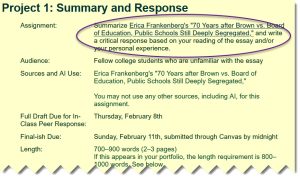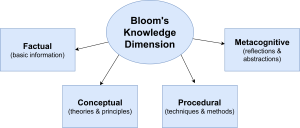Understanding Writing Assignments as Intellectual Work
To better understand the type of intellectual work that your professors are looking for, you can turn to Bloom’s Taxonomy. Remember that Bloom’s was originally developed to help teachers better articulate the work that they hope to see from their students.
Even if Bloom’s hasn’t been intentionally employed by your instructor, you can still use this model. Those four types of knowledge and six types of cognitive processes are embedded in the assignments because these are the types of knowledge and intellectual activity that professors want to see. No intention required.
This section is about looking at Bloom’s Taxonomy in action.
- In this chapter, we’ll look at general principles for how to approach writing assignments using Bloom’s.
- In the next four chapters, we’ll examine some actual writing assignments using this model.
- In the final chapter in this section, I’ll talk about why understanding the intellectual work of assignments matters.
I frequently hear this question from students about their writing assignments, and most of the time, I cringe. “Right” and “wrong” have little to do with writing in general because except for technical matters like grammar and citation, there is little about writing that involves correctness.
I am almost never interested in whether my students can follow step-by-step instructions or write something the way I would write it. Instead, I want to see how they approach the writing tasks and topics I’ve assigned. I’m interested in their thinking and how that thinking shows up in their writing.
And there are definitely better questions to ask:
“I think [x] would be a good topic for this assignment. Do you agree?”
“I’m trying to communicate [x]. Am I doing that in this paragraph (or paper or sentence)?”
“I think [Author Y] is wrong about [x], and here’s why. Am I missing something?”
Do you see how these questions get at intellectual work? Better questions get better answers!
Using Bloom’s Taxonomy to identify the intellectual work of an assignment involves three parts:
- Finding the key sentences in an assignment
- Identifying the verbs in those sentences
- Identifying the kinds of knowledge those verbs are asking you to work with.
We’ll take each of these in turn.
Finding Key Sentences
First, we need to find key sentences, the ones that describe the task(s) in an assignment. When I say “key sentence,” I’m looking for sentences that tell me (the writer of the assignment) the job that I have to do.
Look for sentences that do the following (though not necessarily all of these):
- Give you directions
- Describe what the final project will include or do
- Use the words “should” or “must”
 Generally, you will only find a handful of key sentences, maybe three or four—and sometimes only one or two. You’ll usually find them at key points in the assignment:
Generally, you will only find a handful of key sentences, maybe three or four—and sometimes only one or two. You’ll usually find them at key points in the assignment:
- These often appear as first sentences in paragraphs.
- Sometimes, they are set off by themselves.
- Sometimes, professors will highlight or bold words.
- Sometimes these sentences use imperative verbs.
While the assignments you get may be long, much of that length is detail to make the directions clearer or more specific, and you won’t find key sentences in those details. Don’t ignore those details—you’ll definitely need them as you work on your project. But when you are trying to understand the key intellectual work of an assignment, you won’t find it in the specifics, much like you won’t find the main point of a reading in the examples.
The key sentences you locate should give you two kinds of information: the kinds of work the assignment is asking you to do and the kinds of knowledge you are expected to use as you do that work.
Identifying Verbs
Once you have the key sentences, you can find the intellectual work of the assignment in the verbs of those sentences.
Both pyramid models I’ve included in the previous chapter—and most of the models you’ll find online—provide a list of verbs that are connected with specific cognitive process dimensions. Since verbs are about actions, it makes sense that verbs would be important for understanding the kinds of tasks that professors want students to do.
This means that you have to be able to find the verbs in your assignments.
I have a longer section on finding verbs in the chapter on editing, but here’s the short version: Change the time. In the English language, verbs hold most (though not all) of the sense of time in a sentence, so if you change a sentence from past to present or vice versa, look for the words that change. There you’ll find the verb(s).
View the example.
Let’s take a key sentence from one of my assignments to see how we can use changes in time to locate verbs:
“As a whole, your paper should effectively explain the barriers.”
What kind of time is this sentence operating in? That “should” gets us to think about something that isn’t done yet, something that will happen in the future, but “should” doesn’t always mean future. Think about how you should eat your spinach, but you don’t.
Still, words like “should” (and “could” and “might” and other modals appear a lot in assignments, but they are never the main verb in a sentence. Therefore, we can eliminate them:
“As a whole, your paper effectively explains the barriers.”
Notice that when we get rid of “should,” we have to change “explain” to “explains” to make the sentence grammatically correct. That’s a clue, but let’s keep going.
We now have a sentence that is clearly set in the present time . Now change it to the past:
“As a whole, your paper effectively explained the barriers.”
We have now located the verb: explain.
The verbs hold the key to understanding the cognitive process(es) that your professor is looking for. If the cognitive process of the verbs isn’t obvious, you can compare those verbs to the lists of verbs in the diagrams of Bloom’s Taxonomy. And bingo! You’ll better understand the intellectual work of the assignment.
Identifying Kinds of Knowledge
The kinds of knowledge will often be found in the nouns in the key sentences. Look for words that signal specific topics or subject matter.
Using the verbs you have found, ask yourself questions like the following:
- What are you supposed to explain or demonstrate or compare or critique?
- What are you supposed to demonstrate as part of your experiment or argument or design?
- What ideas or concepts from class or your readings are you supposed to use?
 With these topics in mind, you can think about them in relation to the knowledge dimension of Bloom’s. Are you working with factual, conceptual, procedural, or metacognitive knowledge? Determining the kinds of knowledge will help you make sure that you are doing the kind of intellectual work that the assignment is asking for.
With these topics in mind, you can think about them in relation to the knowledge dimension of Bloom’s. Are you working with factual, conceptual, procedural, or metacognitive knowledge? Determining the kinds of knowledge will help you make sure that you are doing the kind of intellectual work that the assignment is asking for.
Key Points: Understanding Writing Assignments as Intellectual Work
- To figure out the intellectual work of writing assignments, you need to identify key sentences. Then you need find the verbs in those sentences and determine the information you need to be working with to do the work implicit in those verbs.
- To identify key sentences, look for the sentences that give you directions, describe what the project does or includes, and/or that use words like “should” and “must.”
- To identify the verbs in those sentences, change the time of the sentence. Usually it’s easiest to change present to past or vice versa. The word that changes is the verb.
- Compare those verbs to the cognitive process dimension of Bloom’s Taxonomy to better understand the kinds of work that your professor wants you to do.
- To identify the kinds of knowledge that you need to work with for your assignment, find the topic or subject matter to which you are supposed to apply the verbs in the key sentences. Usually these will be the nouns in those sentences.
- Compare those topics to the descriptions of the categories in the knowledge dimension of Bloom’s Taxonomy to better understand the kinds of knowledge your professor wants you to demonstrate or produce as part of the assignment.
Media Attribution
Alexandre Francois provided the inspiration for the diagram of Bloom’s knowledge dimension.
Text Attribution
Text in this section was revised with the help of Alexandre Francois, Ramire Johnson, Elizabeth Mahoney, and Christal Page, students in my class during Fall 2023.
A verb that gives a command. In “Wash the dishes,” “wash” is the imperative verb.
An auxiliary verb that helps indicate what is needed or what is possible in the action of the main verb. Examples include "should" and "might."

